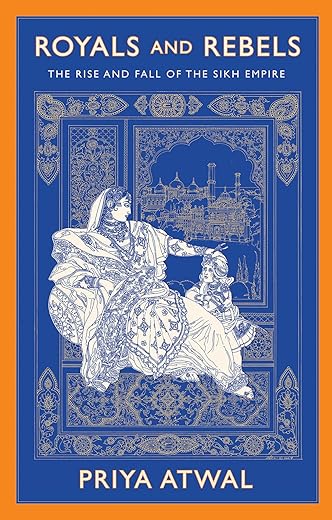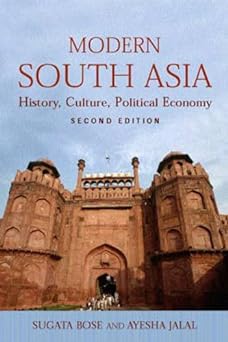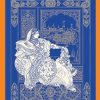Royals and Rebels: The Rise and Fall of the Sikh Empire
£14.50£15.20 (-5%)
In late-eighteenth-century India, the glory of the Mughal emperors was fading, and ambitious newcomers seized power, changing the political map forever. Enter the legendary Maharajah Ranjit Singh, whose Sikh Empire stretched throughout northwestern India into Afghanistan and Tibet. Priya Atwal shines fresh light on this long-lost kingdom, looking beyond its founding father to restore the queens and princes to the story of this empire’s spectacular rise and fall. She brings to life a self-made ruling family, inventively fusing Sikh, Mughal and European ideas of power, but eventually succumbing to gendered family politics, as the Sikh Empire fell to its great rival in the new India: the British. Royals and Rebels is a fascinating tale of family, royalty and the fluidity of power, set in a dramatic global era when new stars rose and upstart empires clashed.
Read more
Additional information
| Publisher | C Hurst & Co Publishers Ltd (6 April 2023) |
|---|---|
| Language | English |
| Paperback | 328 pages |
| ISBN-10 | 1787389642 |
| ISBN-13 | 978-1787389649 |







by N
A really well researched biography of Maharaja Ranjeet Singh, delving deeper into the relations and dynamics between the Sikh King, his mother in law Sada Kaur, and the East India Company. I’m so impressed by how much information was compressed into a short book (200 pages) … there were so many Books, articles and sources used for research and at no point did I feel bogged down with exposition or bored!
They’re were many poignant players in the rise of the Sikh Kingdom, Priya Atwal gives credit to them all; despite being illiterate Maharaja Ranjeet Singh managed to hold down his kingdom whilst juggling between threats from surrounding lands and holding down a large and forever expanding family! Although there are many critical points in Maharaja Ranjeet Singh’s life, Priya focuses on the important turning points as well as the glorious victories, treachery, and never shying away from the sordid gossipy rumours of Ranjeet’s Durbar, and with so many wives, concubines and well just debauchery there was bound to be lots of drama!!! Although Maharaja Ranjeet Singh acknowledged his first born karruck Singh, he was less forthcoming with his other sons.. however the burning question is whether he ever had daughter…no one has ever touched upon this point!
On the whole Royals and Rebels was a really enjoyable read, up there with the likes of Paswant Singh and Kushant Singh… I managed to finish this in two sitting!!
by D_S
Indian history enthusiasts are very familiar with Ranjit Singh- the man who built a Sikh Empire extending from Jammu & Kashmir to the Afghan borderlands. He was friendly but guarded with the British newcomers of the East India Company, and built an alliance of equals with them. This book goes beyond him to look at his prominent sons and maharanis. The author Priya Atwal has shown that both British and Punjabi accounts have overlooked these royals, due to the focus on Ranjit Singh and also sexism.
Ranjit Singh in fact invested a great deal of effort and resources in training his sons to become princes. In their pre-teen years they were on battlefronts, and as teenagers they entertained British envoys to the Empire. They would not have been as competent as Ranjit Singh, but Kharak Singh and Nau Nihal Singh could’ve made decent enough emperors if not for their tragic and suspiciously sudden deaths. The fierce Khalsa Army, which had been the backbone of the Sikh conquests, fell into a Praetorian Guard role as it clashed and allied with various claimants to the throne.
This Punjabi Game of Thrones included two ambitious and bold women: Chand Kaur and Jind Kaur. These two widows of Ranjit Singh challenged Punjabi gender roles. Although a few Sikh women like Ranjit Singh’s own mother-in-law had been active power players in the Sikh Empire, most were not given credibility as rulers. Chand Kaur and Jind Kaur both defied this, shocking their Punjabi and British rivals alike. When the British eventually defeated and annexed the Sikh Empire, the supposedly ‘unIndian’ and ‘wanton’ behaviour of these Maharanis was one of their justifications.
Apart from the character studies of the ‘Royals and Rebels’, Atwal also offers interesting glimpses at other characters of the time. I learned about the treacherous and power-hungry Dogra Rajput family of Singhs; they first plotted against Chand Kaur and Jind Kaur with rival Sikh claimants, before eventually allying with the British in order to seize control of Jammu and Kashmir. The Brits also come off as unique individuals in their own right. Britain’s annexation of Punjab was not a given. The country’s officials respected Ranjit Singh immensely. Even after his death and ensuing succession struggles, the British did not plan to abolish the Sikh Empire. After the Khalsa Army provoked the first Anglo-Sikh War, the British won the conflict but kept the Empire in place under child raja Duleep Singh and his mother Jind Kaur. It was only after the entrance of new British officials, such as Governor General Dalhousie, that ambition to take the Punjab crept in. A full-fledged rebellion from Jind Kaur (who was provoked by Britain sending her into exile and separating Duleep from her) gave Dalhouse the chance to finally extinguish the Sikh state. Ironically, Jind Kaur died in London, where she spent her last two years with her son (who lived as a privileged exile in Britain). Up to her last breath, she reminded her son of his birthright and the past glories of the independent Sikh Empire.
Atwal also gives a solid summary of Sikhism’s origins. Learning about the kingly styles of some of the later Sikh Gurus was fascinating. Atwal draws a line connecting Ranjit Singh back to the final Guru Gobind Singh, who created the Khalsa warrior community and reconciled the relatively egalitarian Sikh religion with royalism. Ranjit Singh’s cultural milieu was shaped by this Mughal period too. He and his sons patronised Persian, along with Mughal style paintings that are shown in the book.
One critique I have of ‘Royals and Rebels’ is that the chronology abruptly skips ahead in places, without explanation or reason. After spending so much time on the princely educations of Khurak and Nau Nihal Singh, Atwal hurriedly skips from their coronations to their deaths. She notes that both deaths were suspicious, but gives little information otherwise. Similarly, Duleep Singh’s life as a deracinated exile in Britain is barely talked about. Atwal writes that his mother rekindled his Sikh heritage, prompting him to seek a royal return to the Punjab, but omits all the details. We next read that he fell into some money problems as he tried to secure a legacy for his family, and eventually sadly died at a hotel in Paris. I had to visit Wikipedia to fill in the blanks. The events of the Second Anglo-Sikh War are also not given enough pages. Apart from that noticeable flaw, this book is a great intro to the overlooked personalities of the Sikh Empire.
by Gurpal
A very well researched piece. It’s easy to read and sets a clear narrative.